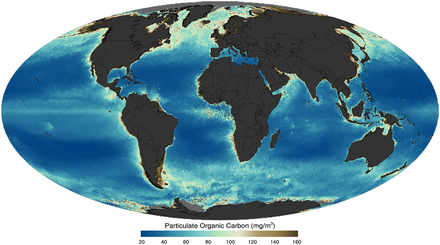
Back كربون عضوي كلي Arabic Celkový organický uhlík Czech Gesamter organischer Kohlenstoff German Carbono orgánico total Spanish Total organic carbon Italian 全有機炭素 Japanese 전유기 탄소 Korean Węgiel organiczny Polish Carbono orgânico total Portuguese Общий органический углерод Russian

Total organic carbon (TOC) is an analytical parameter representing the concentration of organic carbon in a sample. TOC determinations are made in a variety of application areas. For example, TOC may be used as a non-specific indicator of water quality, or TOC of source rock may be used as one factor in evaluating a petroleum play.[1] For marine surface sediments average TOC content is 0.5% in the deep ocean, and 2% along the eastern margins.[2]
A typical analysis for total carbon (TC) measures both the total organic carbon (TOC) present and the complementing total inorganic carbon (TIC), the latter representing the amount of non-organic carbon, like carbon in carbonate minerals. Subtracting the inorganic carbon from the total carbon yields TOC. Another common variant of TOC analysis involves removing the TIC portion first and then measuring the leftover carbon. This method involves purging an acidified sample with carbon-free air or nitrogen prior to measurement, and so is more accurately called non-purgeable organic carbon (NPOC).[3]
- ^ "Technically Recoverable Shale Oil and Shale Gas Resources: An Assessment of 137 Shale Formations in 41 Countries Outside the United States" (PDF). U.S. Energy Information Administration (EIA). June 2013. Retrieved June 11, 2013.
- ^ Seiter, Katherina; Hensen, Christian; Schröter, Jürgen; Zabel, Matthias (2004). "Organic carbon content in surface sediments—defining regional provinces". Deep-Sea Research Part I: Oceanographic Research Papers. 51 (12): 2001–2026. Bibcode:2004DSRI...51.2001S. doi:10.1016/j.dsr.2004.06.014.
- ^ Lenore S. Clescerl; Arnold E. Greenberg; Andrew D. Eaton (1999). Standard Methods for Examination of Water & Wastewater (20th ed.). Washington, DC: American Public Health Association. ISBN 0-87553-235-7. Method 5310A. Also available by online subscription at www.standardmethods.org
© MMXXIII Rich X Search. We shall prevail. All rights reserved. Rich X Search